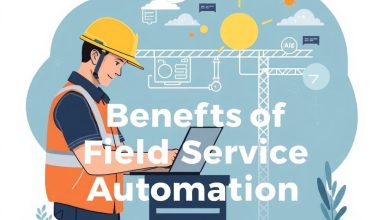Field Service Management with Weather-Aware Routing Optimizing Mobile Workforce Operations

Introduction
Field Service Management (FSM) is a critical component of many businesses, particularly in industries such as HVAC, electrical work, plumbing, and home maintenance. As companies strive to provide efficient and effective services to customers, they often face challenges related to scheduling, resource allocation, and route optimization. One significant factor that can impact field service operations is weather conditions. Inclement weather can cause delays, increase travel times, and even force technicians to cancel appointments altogether.
In recent years, there has been a growing trend towards implementing weather-aware routing systems in FSM software. These advanced solutions use real-time weather data and predictive analytics to optimize routes and improve overall operational efficiency. This article will explore the concept of weather-aware routing in field service management, its benefits, implementation strategies, and best practices.
The Challenge of Traditional Route Planning
Traditional route planning methods for field service operations typically rely on static factors such as distance between locations, traffic patterns, and fixed schedules. However, these approaches often fail to account for dynamic elements like weather conditions, which can significantly impact travel times and appointment completion rates.
Weather-related issues can lead to:
- Increased travel times due to slower speeds during rain or snow
- Road closures caused by flooding or heavy snowfall
- Reduced visibility affecting driving safety
- Technicians being unable to reach customer locations safely
These challenges result in missed appointments, delayed service delivery, and reduced customer satisfaction. Moreover, traditional routing methods may not adapt quickly enough to changing weather conditions, leading to suboptimal use of resources and inefficient operations.
Weather-Aware Routing: A Solution to Weather-Related Challenges
Weather-aware routing takes a more proactive approach to addressing the challenges posed by inclement weather. By integrating real-time weather data and forecasts into the routing algorithm, this technology enables field service organizations to:
- Predict potential disruptions before they occur
- Adjust routes dynamically based on current and forecasted weather conditions
- Optimize travel times and reduce the risk of delays
- Improve first-time fix rates by ensuring technicians have the necessary tools and materials
By leveraging weather intelligence, field service companies can enhance their ability to manage resources effectively, maintain high levels of customer satisfaction, and ultimately drive business growth.
How Weather-Aware Routing Works
Weather-aware routing systems typically incorporate several key components:
Real-Time Weather Data Integration
These systems collect and analyze current weather conditions from various sources, including:
- National Weather Service (NWS) reports
- Local weather stations
- Satellite imagery
- Crowd-sourced data from mobile devices
This real-time data allows the system to understand immediate weather impacts on field operations.
Predictive Analytics
Advanced algorithms process historical weather data and current conditions to predict future weather patterns. This forecasting capability enables the system to anticipate potential disruptions well in advance.
Dynamic Route Adjustment
Based on the integrated weather data and predictive analytics, the routing system continuously recalculates optimal routes. It considers factors such as:
- Current road conditions
- Weather-related speed limits
- Potential road closures
- Time windows for each appointment
This dynamic adjustment ensures that routes are optimized in real-time, taking into account the latest weather information.
Benefits of Weather-Aware Routing for Field Service Management
Implementing weather-aware routing can bring numerous benefits to field service operations:
- Improved On-Time Performance: By accounting for potential delays caused by weather, companies can reduce missed appointments and improve overall on-time performance.
- Enhanced Resource Allocation: Dynamic routing ensures that resources are allocated efficiently, minimizing unnecessary travel time and optimizing vehicle utilization.
- Increased Customer Satisfaction: When technicians arrive at scheduled times or even earlier due to optimized routes, customer satisfaction levels tend to increase.
- Reduced Fuel Consumption: By avoiding unnecessary detours and optimizing routes based on real-time conditions, companies can lower their fuel costs and reduce their carbon footprint.
- Better Safety Record: Weather-aware routing helps ensure that technicians avoid hazardous road conditions, potentially reducing accidents and improving overall safety.
- Cost Savings: The combination of improved efficiency and reduced fuel consumption can lead to significant cost savings for field service organizations.
Implementation Strategies
To successfully implement weather-aware routing in FSM systems, consider the following strategies:
- Data Integration: Ensure seamless integration with existing FSM software and data sources. This may involve API connections or data feeds from weather services.
- User Training: Provide comprehensive training to field service managers and technicians on how to interpret and act upon weather-related route information.
- Regular Updates: Keep the system updated with the latest weather data and forecasting models to maintain accuracy and effectiveness.
- Customization: Allow for customization of weather parameters and alerts to suit specific business needs and regional conditions.
- Monitoring and Feedback: Implement a system for monitoring the impact of weather-aware routing and gathering feedback from users to continuously improve the solution.
Best Practices for Weather-Aware Routing
To maximize the benefits of weather-aware routing, consider these best practices:
- Combine Weather Intelligence with Other Optimization Techniques: While weather awareness is crucial, it should be integrated with other optimization techniques such as traffic patterns and historical appointment data.
- Use Multiple Weather Sources: Rely on multiple weather data providers to ensure accurate and up-to-date information.
- Set Appropriate Time Windows: Adjust appointment windows based on weather forecasts to account for potential delays.
- Prioritize High-Risk Locations: Identify areas prone to severe weather events and prioritize scheduling in those regions when possible.
- Communicate with Customers: Inform customers about any potential impacts of weather on their scheduled appointments and provide updates if necessary.
Conclusion
Field Service Management with weather-aware routing represents a significant advancement in operational efficiency and customer satisfaction. By leveraging real-time weather data and predictive analytics, companies can optimize their field service operations, reduce costs, and improve overall performance.
As technology continues to evolve, we can expect further improvements in weather-aware routing systems. These advancements will likely include more sophisticated AI-driven decision-making, integration with emerging transportation technologies like autonomous vehicles, and even personalized routing based on individual technician preferences and driving styles.
For field service managers looking to stay competitive in today’s fast-paced business environment, implementing weather-aware routing is not just a nice-to-have feature – it’s a must-have capability for efficient and effective field service management.




